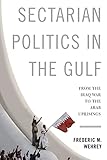Sectarian Politics in the Gulf : From the Iraq War to the Arab Uprisings / Frederic Wehrey.
Material type: TextSeries: Columbia Studies in Middle East PoliticsPublisher: New York, NY : Columbia University Press, [2013]Copyright date: ©2013Description: 1 online resource (352 p.) : ‹B›B&W Illus.: ‹/B›1Content type:
TextSeries: Columbia Studies in Middle East PoliticsPublisher: New York, NY : Columbia University Press, [2013]Copyright date: ©2013Description: 1 online resource (352 p.) : ‹B›B&W Illus.: ‹/B›1Content type: - 9780231165129
- 9780231536103
- 953.054 23
- DS247.A138 W44 2014
- DS247.A138 W44 2015
- online - DeGruyter
- Issued also in print.
| Item type | Current library | Call number | URL | Status | Notes | Barcode | |
|---|---|---|---|---|---|---|---|
 eBook
eBook
|
Biblioteca "Angelicum" Pont. Univ. S.Tommaso d'Aquino Nuvola online | online - DeGruyter (Browse shelf(Opens below)) | Online access | Not for loan (Accesso limitato) | Accesso per gli utenti autorizzati / Access for authorized users | (dgr)9780231536103 |
Frontmatter -- Contents -- Acknowledgments -- Introduction -- List of Abbreviations -- PART I. THE ROOTS OF SECTARIANISM -- 1. Governance, Society, and Identity in the Gulf -- 2. The Long Shadow of the Iranian Revolution -- PART II. BAHRAIN -- 3. Debating Participation -- 4. Sectarian Balancing -- 5. Into the Abyss -- PART III. SAUDI ARABIA -- 6. Loyalties Under Fire -- 7. Under Siege -- 8. Waving ʿUthman's Shirt -- PART IV. KUWAIT -- 9. Renegotiating a Ruling Bargain -- 10. Tilting Toward Repression -- 11. A Balancing Act Goes Awry -- Conclusion -- Notes -- Bibliography -- Index
restricted access online access with authorization star
http://purl.org/coar/access_right/c_16ec
One of Foreign Policy's Best Five Books of 2013, chosen by Marc Lynch of The Middle East ChannelBeginning with the 2003 invasion of Iraq and concluding with the aftermath of the 2011 Arab uprisings, Frederic M. Wehrey investigates the roots of the Shi'a-Sunni divide now dominating the Persian Gulf's political landscape. Focusing on three Gulf states affected most by sectarian tensions-Bahrain, Saudi Arabia, and Kuwait-Wehrey identifies the factors that have exacerbated or tempered sectarianism, including domestic political institutions, the media, clerical establishments, and the contagion effect of external regional events, such as the Iraq war, the 2006 Lebanon conflict, the Arab uprisings, and Syria's civil war.In addition to his analysis, Wehrey builds a historical narrative of Shi'a activism in the Arab Gulf since 2003, linking regional events to the development of local Shi'a strategies and attitudes toward citizenship, political reform, and transnational identity. He finds that, while the Gulf Shi'a were inspired by their coreligionists in Iraq, Iran, and Lebanon, they ultimately pursued greater rights through a nonsectarian, nationalist approach. He also discovers that sectarianism in the region has largely been the product of the institutional weaknesses of Gulf states, leading to excessive alarm by entrenched Sunni elites and calculated attempts by regimes to discredit Shi'a political actors as proxies for Iran, Iraq, or Lebanese Hizballah. Wehrey conducts interviews with nearly every major Shi'a leader, opinion shaper, and activist in the Gulf Arab states, as well as prominent Sunni voices, and consults diverse Arabic-language sources.
Issued also in print.
Mode of access: Internet via World Wide Web.
In English.
Description based on online resource; title from PDF title page (publisher's Web site, viewed 02. Mrz 2022)


